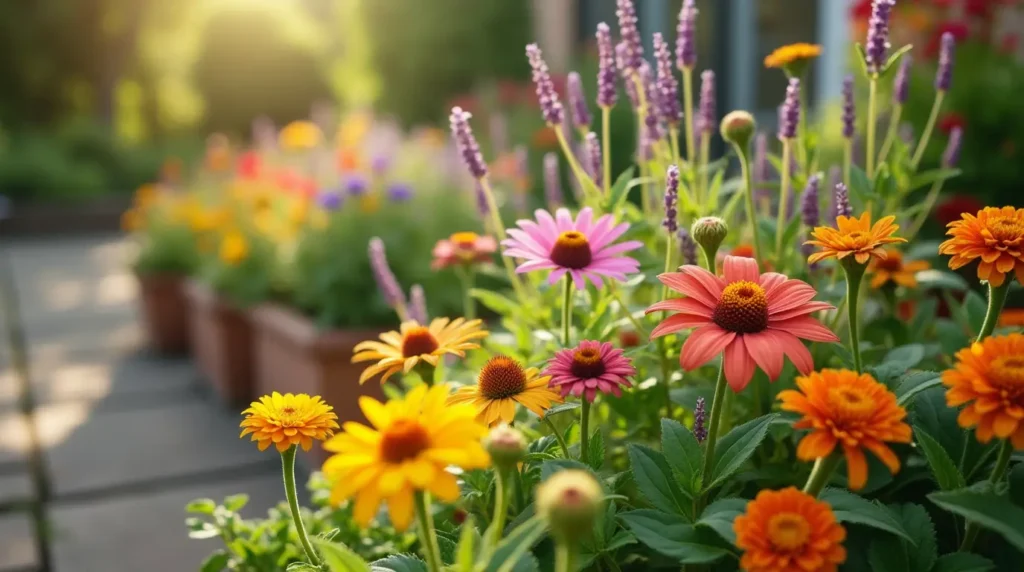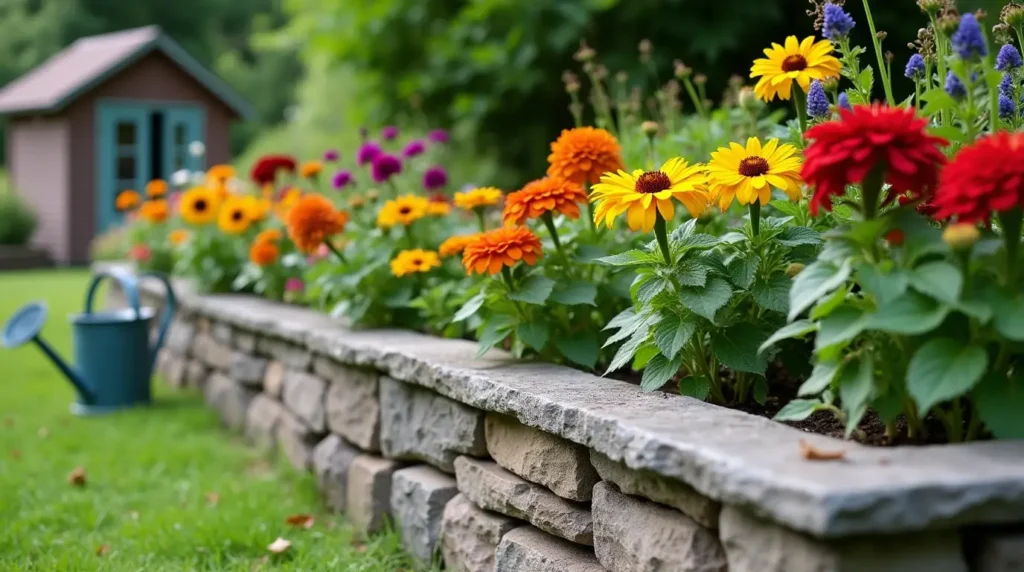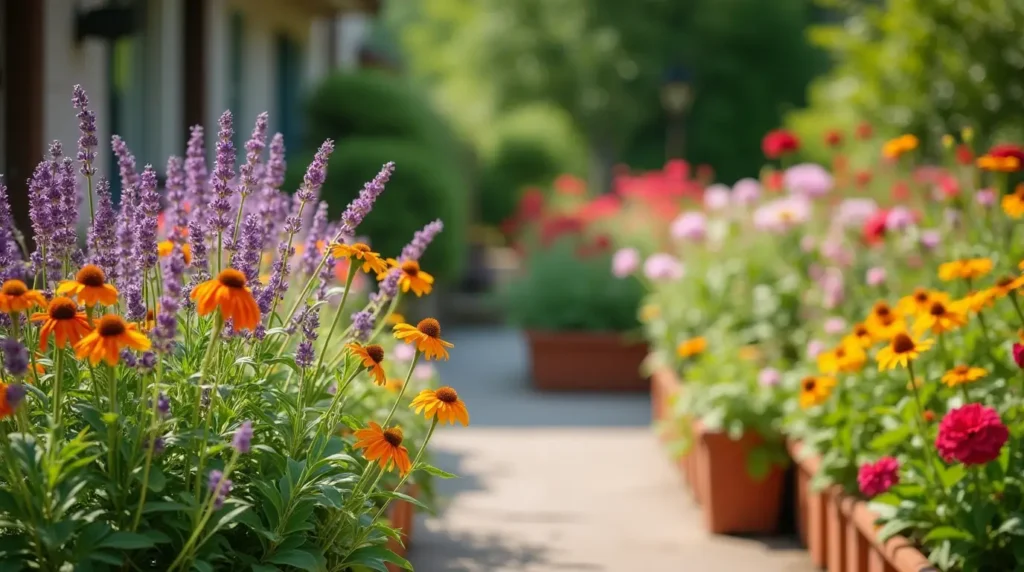Welcome to Your Flourishing Garden
Discover the joy of gardening with easy-care flowers that thrive on little attention! You don’t need a green thumb to create a stunning outdoor space. With the right flowers, you can transform your garden into a vibrant oasis without the stress of constant upkeep.
In this article, you’ll learn about resilient flower varieties that are perfect for beginners and seasoned gardeners alike. Each section will provide you with practical tips, from planting to arranging, ensuring your garden remains blooming throughout the year. So, get ready to embrace the beauty of nature and enjoy the satisfaction of a flourishing garden with flowers you simply can’t kill!




Top Easy-Care Perennial Flowers You’ll Love!
Understanding Easy-Care Flowers
When considering flowers for your garden, the phrase “easy-care” means more than just minimal effort; it encapsulates a set of traits that make them ideal for busy lives or novice gardeners. But what exactly defines these gems of low-maintenance gardening?
Resilience to Various Conditions
Easy-care flowers are known for their ability to flourish in various environmental conditions, from scorching sun to partial shade. Their robust nature allows them to thrive under less-than-ideal situations, making them a perfect fit for those who might not have time for constant monitoring. Many of these flowers have:
Ideal for Busy Gardeners
For those of you balancing work, family, and social commitments, easy-care flowers can provide a touch of nature without overwhelming you. Imagine coming home to a garden adorned with colorful blooms—all achieved with minimal watering and fertilization! They can often go weeks without care, allowing you to simply enjoy their beauty.
A great example of such a resilient flower is the Aubrieta, a hardy perennial that not only delivers vibrant colors but requires very little maintenance once established.
Low Maintenance Needs
Typically, easy-care flowers are perennial varieties that return year after year, saving you the hassle of replanting seasonal blooms annually. They usually require:
By understanding what makes flowers easy to care for, you’re setting the foundation for a flourishing garden that fits seamlessly into your lifestyle. Next, let’s explore some of the most popular easy-care flower varieties you won’t want to miss!

Top Ten Easy-Care Flower Varieties
Explore a curated list of ten stunning, low-maintenance flowers that are perfect for your garden. From perennial favorites to annual blooms, you’ll discover which flowers will flourish in your outdoor space with minimal effort.
1. Daylilies (Hemerocallis)
These perennial stars are the bread and butter of easy-care gardening. Daylilies are incredibly adaptable and come in a variety of colors. Once established, they thrive with little help and can even survive in poor soil. Plus, every bloom lasts just a day, but the plant continues to produce an abundance throughout the growing season!
2. Black-eyed Susans (Rudbeckia)
With their bright yellow petals and dark centers, Black-eyed Susans add a cheerful touch to any garden. They thrive in full sun and can tolerate drought, making them perfect for a low-maintenance setup. Just plant them and watch them reseed year after year!
3. Lavender (Lavandula)
Not only does lavender provide a beautiful pop of purple, but it releases a calming fragrance that many adore. It requires well-drained soil and plenty of sunlight. With minimal watering, this fragrant herb can thrive beautifully in your garden.
4. Sedum (Stonecrop)
Sedum varieties are succulent perennials that require hardly any care. They are drought-tolerant and excel in poor soils, making them ideal for rock gardens or borders. They come in various textures and colors, ensuring your garden remains visually striking.
5. Zinnias
For vibrant annual blooms, look no further than zinnias! These sun-loving flowers are available in a rainbow of colors and are highly resistant to pests. Just plant them in full sun, and they’ll reward you with continuous blooms all summer long.
6. Coneflowers (Echinacea)
These hardy perennials not only attract pollinators but are also tolerant of heat and drought. Coneflowers bloom from early summer to fall, adding beautiful color and texture to your garden without demanding much care.
7. Pansies
Perfect for cooler months, pansies offer vibrant hues that can brighten any space. They are fairly resilient and can handle a bit of frost, making them ideal for spring and fall displays.
8. Coreopsis (Tickseed)
Known for their cheerful daisy-like flowers, Coreopsis is a drought-tolerant perennial. They bloom profusely from early summer until frost, needing just a little deadheading to keep them going strong.
9. Marigolds
These annual blooms are not only easy to grow but also act as natural pest deterrents. Marigolds thrive in full sun and require little attention—just plant and enjoy their lively colors!
10. Russian Sage (Perovskia atriplicifolia)
This perennial features stunning silver foliage with tall spikes of light purple flowers. It’s drought-tolerant, aromatic, and adds a unique texture to your garden landscape.
With these ten fabulous varieties, you’ll soon have a garden bursting with color and life, all while enjoying low-maintenance beauty! Next, let’s delve into practical tips for planting and caring for these delightful blooms to ensure your garden remains a flourishing paradise.
Tips for Planting and Caring for Easy Flowers
To ensure your easy-care flowers thrive, let’s explore some practical tips for planting and maintaining them. With the right techniques, you can create a flourishing garden with minimal effort.
Choosing the Right Location
The first step in planting your flowers is selecting the ideal spot in your garden. Here are a few key tips to help you find the best location:
Preparing the Soil
Proper soil preparation sets the stage for successful growth. Follow these simple steps:
Watering Wisely
Understanding the watering needs of your flowers will promote healthier growth:
Maintenance and Care
Once your flowers are planted, basic care will go a long way:
Implementing these straightforward strategies will pave the way for a thriving and vibrant flower garden. As you become familiar with caring for your blooms, you’ll be excited to learn about how to arrange them beautifully in your outdoor space!

Arranging Your Flower Garden
Arranging your easy-care flowers is an exciting step that combines creativity with a touch of botanical knowledge. With just a few fundamental principles, you can transform your garden into a stunning display of colors and textures that reflects your personal style.
Color Combinations
One of the most enjoyable aspects of flower arranging is playing with color. Consider using the color wheel as your guide. Complementary colors, such as yellow and purple or red and green, create vibrant contrasts that draw the eye. Alternatively, analogous colors, like blue, blue-green, and green, provide a more serene and cohesive look. Mixing these schemes can enliven your garden, adding depth and intrigue.
Height Variation
To add dimension to your garden, plan your design with height in mind. Plant taller flowers, like Russian Sage and Coneflowers, at the back of borders or the center of circular beds. Medium-height flowers, such as Black-eyed Susans and Daylilies, can occupy the middle space, while shorter blooms like Zinnias and Marigolds should be in the front.
This staggered arrangement ensures that every flower has its moment in the spotlight. Just imagine a backdrop of towering blooms emerging from a vibrant tapestry below, creating a dynamic and breathtaking scene.
Seasonal Layering
To enjoy a blooming garden throughout the seasons, consider planting flowers that blossom at different times. Begin with early bloomers, such as Pansies, followed by mid-summer favorites like Coreopsis. Finally, add late bloomers like Sedum and Asters to sustain your garden’s vitality into fall. Seasonal layering not only increases the visual appeal but also enhances biodiversity, attracting various pollinators.
By thoughtfully arranging your flowers according to color, height, and seasonal blooming periods, you will cultivate a picturesque and flourishing garden. Up next, let’s tackle some common gardening challenges to help you keep your easy-care flowers thriving all season long!
Troubleshooting Common Garden Problems
Even the most beginner-friendly flower gardens can face occasional hiccups. Having a solid troubleshooting toolkit will empower you to tackle challenges like pests, diseases, and other issues with confidence. Here’s a breakdown of common problems you might encounter and practical solutions to help you nurture your garden back to health.
Pests: Your Garden’s Unwelcome Guests
Pests can be a significant nuisance, but early intervention can save your flowers:
Disease Diagnosis
Identifying plant diseases rapidly can save your beautiful blooms:
Environmental Issues
Sometimes, your flowers may struggle due to environmental stress:
With these tools in hand, you’ll be well-equipped to maintain your flowering haven and ensure it thrives despite the occasional setback. As you continue to cultivate your knowledge, it’s essential to think about how to provide year-round care for your garden’s blooms. Let’s explore seasonal tips next!
Seasonal Care for Year-Round Blooms
To keep your easy-care flowers thriving throughout the year, understanding seasonal needs is crucial. With a little attention and planning, you can ensure your garden continually bursts with color. Here’s how to manage your blooms across different seasons.
Spring Awakening
As the growing season begins, focus on cleaning up your garden beds. Remove any debris or dead leaves from winter, which can harbor pests and diseases. This is also a great time to divide any overcrowded perennials. When planting, opt for fertilizers that promote healthy root growth. A product like Miracle-Gro Shake 'N Feed All Purpose Food can give your plants a nutrient boost at this critical stage.
Summer Vibrancy
During the hot months, consistent watering is key, especially as blooms begin to peak. Look for flowers that thrive in the heat, such as Daylilies and Echinacea. Keep an eye on your flowers for signs of stress. If leaves start drooping, it might be time to provide some extra hydration. Regular deadheading will keep blooms appearing and encourage the plants to produce more flowers throughout the summer months.
Autumn Transition
As flowers begin to fade in the fall, it’s important to prepare them for the colder months ahead. Trim back any spent foliage and consider adding a fresh layer of mulch to protect plant roots from winter frost. This is also an ideal time to plant spring-blooming bulbs like Tulips and Daffodils. They will add excitement to your garden in the following season.

Winter Protection
When the chill settles in, your garden requires special care. For perennial flowers, a good protective blanket of mulch helps insulate roots against freezing temperatures. If you live in particularly harsh climates, consider covering delicate plants with burlap or frost cloths. Even in winter, you can enjoy your garden; consider planting winter-bloomers that can provide color and interest, such as Hellebores.
With these seasonal strategies, you’ll be well-equipped to foster a garden that flourishes, no matter the time of year. As you care for your flowers through the seasons, you’ll find joy and satisfaction in nurturing your vibrant outdoor space. Now, let’s wrap up with some final thoughts on how you can fully enjoy the fruits of your labor!
Sow, Grow, and Enjoy Your Garden
As you embark on your gardening adventure, remember that cultivating easy-care flowers can fill your space with beauty and joy, all while requiring minimal effort. Each bloom you nurture is a testament to your green thumb and a reminder of nature’s resilience.
Take pride in maintaining your vibrant outdoor oasis, and don’t hesitate to share your journey with others. Whether you enjoy a short stroll through your colorful garden or invite friends to share in its splendor, each visit will remind you of the rewards of your hard work. So grab your gardening tools, sow those seeds, and watch as your garden flourishes with life. Happy gardening!
Frequently Asked Questions
What are easy-care flowers?
Easy-care flowers are low-maintenance plants that thrive with minimal attention. They’re ideal for busy or beginner gardeners, offering resilience to pests, drought, and various weather conditions.
Which flowers are best for a low-maintenance garden?
Top choices include Daylilies, Lavender, Coneflowers, Black-eyed Susans, and Sedum. These plants need little water and attention while providing vibrant, long-lasting blooms.
Do easy-care flowers bloom every year?
Many easy-care flowers are perennials, meaning they return year after year. Examples include Russian Sage, Coreopsis, and Coneflowers. Others, like Zinnias, are annuals and need replanting.
How should I arrange easy-care flowers in my garden?
Group flowers by height and bloom time. Place taller varieties in the back and shorter ones in front. Mix colors and layer blooming seasons to keep the garden attractive all year.
Do these flowers require fertilizer?
Most easy-care flowers thrive with minimal feeding. Use a slow-release fertilizer in spring for better growth and blooming. Avoid over-fertilization to keep plants healthy.
Can I grow easy-care flowers in containers?
Yes! Flowers like Pansies, Marigolds, and Petunias do very well in pots. Ensure proper drainage and water regularly, especially in hot weather.



As a newbie, I appreciate the tips for planting and care! I always wondered when to plant—spring or fall? Any suggestions?
Spring is ideal for most flowers, but some hardy perennials can go in the fall. Just be sure to check the specific flower type!
It’s usually best to plant in spring, but some perennials can be planted in fall too. It really depends on the flower.
I tried growing flowers before and failed miserably. 😩 Hoping these tips help since I’m stubborn and want to try again! How do I avoid common mistakes?
Start with the right soil and ensure you’re watering correctly! Overwatering is a common mistake.
Pay attention to sun exposure too! Some flowers need full sun while others prefer shade.
I think this is a great guide, but it felt a bit overwhelming at times. Maybe break info into bullet points next time? Just a suggestion!
Thanks for the feedback, Bobby! We’ll definitely consider bullet points in future articles.
Lol, I felt the same at first! It’s all about finding which flowers speak to you. 😊
I love the seasonal care section! I always forget to care for them in the winter. Gonna look into the Miracle-Gro Shake ‘N Feed for sure! 🌻 Anyone here use it?
I use it every year! My blooms come out beautiful. Just the right balance of nutrients!
Yes! Miracle-Gro products are usually fantastic for boosting growth. It’s great for a variety of situations.
Hey, the gardens looked awesome in the article! 🌺 I think I’ll try the planner too. I need serious help with organization! 😂 Any tips for first-time planners?
Start small, Gloria! Layout your garden on paper first and plan where each flower will go. It can save a lot of headaches later!
I think color-coding your plants might be really helpful! Just to keep it visually organized.
I can’t believe what a mess my flower bed is right now. 😩 Anyone recommend the best way to deal with combines? Just read about the disease control spray mentioned; is it worth it?
The Ortho Rose & Flower Disease Control works great for keeping plants healthy! Just follow the instructions carefully.
Definitely worth a try, Tommy! I used it last season and my roses bloomed beautifully after. 😍
This article is great! The flower varieties section was my favorite. I’m excited about how easy it can be to start gardening! 🙌
Totally! Gardening should be fun! Can’t wait to share my updates!
Glad you enjoyed it, Derek! Let us know how it goes once you plant!
Fun read! 🌷 I’m curious, can these easy-care flowers survive a little neglect? I mean, I sometimes forget to water my plants…
Totally! I barely water mine and they keep coming back! Just be aware of the heat though.
Great question! Many easy-care flowers are drought-resistant, so they can survive some neglect. Aubrieta is a good choice!
Thanks for sharing! I’ve always found flower gardening intimidating. Appreciate the encouragement, and I’m definitely gonna try you’re easy-care flowers! 🌼
It’s all about trial and error! Don’t stress too much; gardens are personal! 😄
You’re welcome, Clara! Remember, it’s about enjoying the process. Happy gardening!
Just started my garden journey this spring and wow! I can’t believe how much info is packed in this article! 🌼 I’m definitely gonna grab those California Giants Zinnia seeds! Do they really attract butterflies?
Absolutely, Samantha! California Giants Zinnias are known for attracting butterflies and bees—perfect for a pollinator-friendly garden!
Yes! They bring in a lot of color and life. I’ve had great luck with them in my garden.